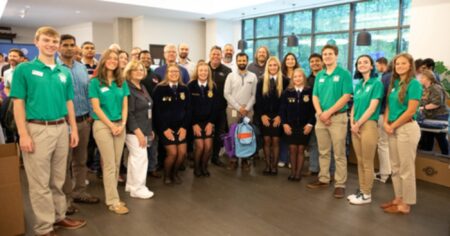Alan States runs a mixed fleet. There’s automatic technology on his Case IH 7250 combine he can’t find anywhere else, and his Fendt Momentum planter handles the terraces without skipping rows.
Whether it’s personal preference or simply iron availability, chances are, you’re also running a mixed fleet. With so many farm management information systems (FMIS) available, keeping track of your fleet during the season and data management at the end of the year can become a headache.
Since returning home from the Vietnam War in 1972, States has grown his mostly one-man operation in Logan, Kansas, to 10,000 acres. He’s tried to remain near the cutting edge of farming practices — he’s been no-till since 1977. In recent years, he’s managed his fleet through Climate FieldView because of how well it meets his operational needs.
“It has to be reliable — when there is a problem, it’s gotta be easy to diagnose and repair,” States said. “It needs to be intuitive enough that you can rapidly train a part-time employee to use it, and to make sure that data is being recorded.”
Connecting Platforms
A single FMIS eases data management. Although a manufacturer may require use of its FMIS, farmers could log in to their choice FMIS, then log in to the manufacturer FMIS and connect the accounts. This would allow machine data from competitive platforms to flow into the choice FMIS, preserving the technical benefits without having to manually transfer equipment data.
“Using a single platform brings your data into one centralized location,” said Grant Truesdale, product marketing manager for CNH Industrial. “You’re not navigating through different portals to find information and manually pulling it — it’s a one-stop shop.”
States described his journey to choosing a platform as an “evolution” and landed on Climate FieldView for its intuitive design and its ease of integration. He said he had tried other FMIS platforms and was disappointed by the price tags and incompatibilities. His com-bine still requires him to go back to Case IH’s FieldOps, but once it is set up for the season, he can operate almost entirely through FieldView.
Manufacturers have a list of compatible APIs available on their FMIS platforms.
Alex Gray
Using a New Platform
AGCO is bringing its FMIS applications under the PTx Trimble umbrella. Modern AGCO-manufactured machines will connect with the factory-installed technology. Older AGCO tractors, and machines from other manufacturers, could connect through the OEM’s FMIS platform or via Precision Planting and PTx Trimble’s retrofit kit.
The kit allows farmers to manage field boundaries, guidance lines, and log coverage such as applied or as planted data. Other packages include an implement electronic control unit (ECU), which can provide variable rate and section control on the attached implement. Machines need a guidance package that includes a display, GPS receiver, and guidance controller.
New Holland offers the CM100 Modem, a generic tracking kit for unified fleet management. This can track the location of any powered machinery — including tractors, sprayers, combines, and trucks — across an operation through New Holland FieldOps.
John Deere’s ultimate goal is to help boost in-field productivity with the Precision Essentials kit. It includes a G5 or G5Plus universal display, StarFire 7500 receiver, and JDLink M or R modem. This kit is designed to help maximize each pass by providing data to eliminate overlaps among machines and prevent input overapplication. The complete Precision Essentials package includes AutoTrac implement guidance and turn automation, AutoPath, in-field data sharing, machine sync, satellite maps, grain harvest weight sharing, and SF-RTK.


:max_bytes(150000):strip_icc()/01-ab68b1ebdc494601bd79753fb5119250.jpg)
:max_bytes(150000):strip_icc()/a-case-of-bird-flu-in-a-missouri-resident-is-the-only-diagnosis-in-the-united-states-this-year-where-the-person-did-not-have-contact-with-infected-dairy-cattle-or-poultry-photo-by-stephen-ausmus-animal-research-services-usda--7c1d7d4efa6b462ea385a2d18133ecbf.jpg)
:max_bytes(150000):strip_icc()/42148500861_b399b29f0c_k-2000-26082808d8964f7bbcc54a564c12afb6.jpg)


:max_bytes(150000):strip_icc()/FarmersgatheredaroundiPad-courtesyAGCO-27f2038960f548f1bb6fc3858583abdb.jpg)


:max_bytes(150000):strip_icc()/Markets-6-Soybeans-down-4-5c803d3936084dd8af48f0509ce76ede.jpeg)